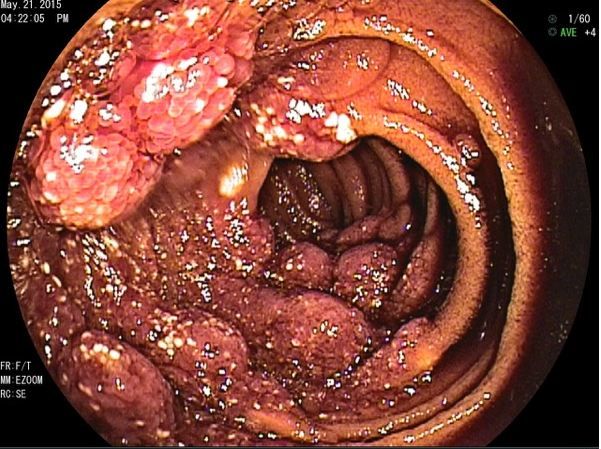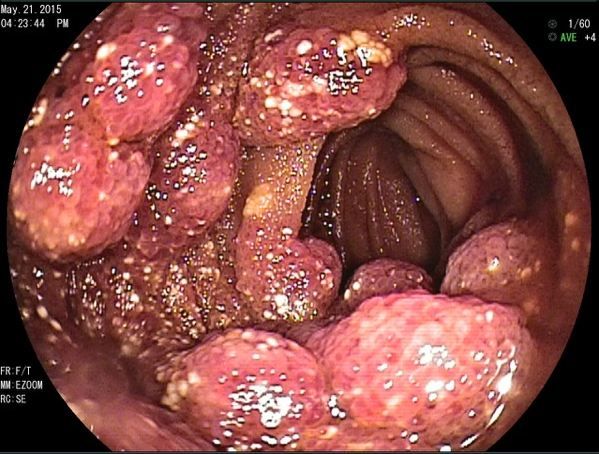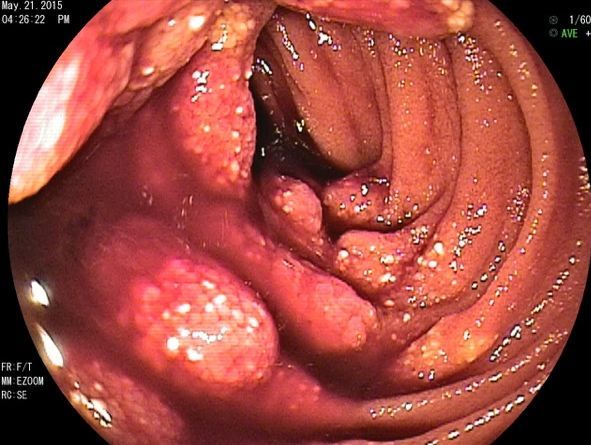- Clinical Technology
- Adult Immunization
- Hepatology
- Pediatric Immunization
- Screening
- Psychiatry
- Allergy
- Women's Health
- Cardiology
- Pediatrics
- Dermatology
- Endocrinology
- Pain Management
- Gastroenterology
- Infectious Disease
- Obesity Medicine
- Rheumatology
- Nephrology
- Neurology
- Pulmonology
A Rare Finding of Lymphangiomatosis: Case Report
Patient was hemoccult positive with anemia but colonoscopy and EGD were negative. What test would you order next?
Figure 1. DBE image showing mid-jejunum polypoid lesions with engorged villi.

Figure 2. Mid-jejunum polypoid lesions with engorged, oozing villi seen on DBE.

Figure 3. DBE image of lesions found in mid-jejunum.

A 48-year-old man who had had a normal physical examination and laboratory findings within normal limits three weeks earlier was incidentally found by his primary care physician to be hemoccult positive. He underwent EGD and colonoscopy, results of which were normal. A few weeks later he began to notice weakness and dyspnea on exertion. Despite his regular exercise routine he became unable to walk short distances of 200-500 feet without having to stop and catch his breath. He remained hemoccult positive, and he presented himself to the emergency room. Laboratory findings revealed a normocytic anemia with a Hgb of 7.9 g/dL and MCV of 85 fL. His abdominal exam was benign and he was admitted to the hospital.
Upon further questioning, the patient reported that he had an episode of anemia of unknown etiology 19 years earlier. At that time he reported having a Hgb of 5 g/dL. Reportedly, a thorough evaluation was performed at that time, including a bone marrow biopsy. All test results were normal. He had not had any follow-up or similar symptoms since then.
The Diagnosis
Given the recent negative findings from the colonoscopy and EGD he was sent for a capsule endoscopy study. The capsule study showed a lesion in the jejunum and he was referred for a push endoscopy. Unfortunately, the lesion could not be reached for biopsy but was tattooed on push endoscopy. It was decided that the patient should undergo a double balloon enteroscopy (DBE) and he was temporarily transferred to one of the few facilities where this procedure was being performed. The DBE showed multiple lesions and masses in the jejunum (Figures 1-3; click to enlarge). The lesions could not be biopsied because they were so friable. The patient underwent CT scan of the abdomen/pelvis with contrast which showed multiple mesenteric nodules or mass lesions with the largest measuring up to 5 cm in the upper abdomen. Surgery was consulted and the patient was sent for small bowel resection; a 20-cm portion of small bowel was removed. There were multiple areas of mesentery with large masses. The resected bowel was sent to pathology. The pathology report provided a definitive diagnosis of lymphangiomatosis (plural of lymphangioma) of the small bowel and mesentery. The patient was subsequently referred to lymphangioma specialists at an out-of-state academic center for lymphangiogram studies.
Discussion
This case illustrates a rare GI tumor causing GI bleeding that was diagnosed only after capsule endoscopy visualized a small intestinal lesion. Lymphangiomas are rare, benign tumors more commonly reported in the pediatric literature. They are lesions of vascular origin and are derived from lymph vessels.1 Intra-abdominal lymphangiomas are even more rare, with less than 1% of lymphangiomas occurring in the intestinal mesentery or retroperitoneal space.1 They usually manifest in early adulthood, and are slow growing.2 In adults, they appear to account for about 2.4% of small bowel tumors.3 Because they are so rare, lymphangiomas are not traditionally considered in the differential for causes of GI bleeding. More recently, as capsule endoscopy has improved and made visualization of the small bowel possible, these lesions have been documented in numerous case reports of GI bleeding in the adult literature.4 The majority of these cases presented with anemia or GI bleeding, although several were incidental and a few presented as abdominal masses/pain.4 The vast majority were treated with resection, although successful treatment with DBE has been reported.5
As imaging modalities, including capsule endoscopy and DBE, continue to improve visualization of the small intestine, the number of lymphangioma diagnoses may increase. The family physician should be alert for signs and symptoms of these rare, benign tumors in adults and consider including them in a differential diagnosis of occult bleeding.
The Takeaway:
⺠Blood loss from a GI bleed is a common cause of anemia.
⺠When a hemoccult positive patient with anemia has a negative colonoscopy and EGD, a capsule study is indicated.
⺠As imaging modalities improve these studies are more likely to discover less common GI tumors including lymphangiomas, which can be diagnosed and treated surgically or with DBE.
(Note: DBE is only available at certain regional medical centers.)
Acknowledgements:
We wish to thank Dr. Brian Chicoine for his thoughtful edits of our manuscript.
References:
1. Majewski M, Lorenc Z, Krawczyk W. Multiannual abdominal pain complicated by obstruction of the gastrointestinal tract in the course of cystic form of mesenteric lymphangioma of the small intestine. Pol JSurgery. 2015;87:185-188.
2. Handa R, Kale R, Harjai MM, Dutta V. Intraabdominal lymphangioma: a case report.MJAFI. 2007;63:80-81.
3. Hanagiri T, Baba M, Shimabukuro T, et al. Lymphangioma in the small intestine: report of a case and review of the Japanese literature.Surg Today. 1992;22:363-367.
4. Morris-Stiff G, Falk GA, El-Hayek K, et al. Jejunal cavernous lymphangioma. BMJ Case Reports. Published online 2011 May 12. doi: 10.1136/bcr.03.2011.4022.
5. Li F, Osuoha C, Leighton JA, Harrison ME. Double-balloon enteroscopy in the diagnosis and treatment of hemorrhage from small-bowel lymphangioma: a case report. Gastrointest Endosc. 2009;70:189-190.
Clinical Tips for Using Antibiotics and Corticosteroids in IBD
January 5th 2013The goals of therapy for patients with inflammatory bowel disorder include inducing and maintaining a steroid-free remission, preventing and treating the complications of the disease, minimizing treatment toxicity, achieving mucosal healing, and enhancing quality of life.
